Hannah Byron's Blog, page 8
November 27, 2022
General De Gaulle’s Free French Movement and SOE

Winston Churchill and Charles de Gaulle during World War 2
Since the end of the Second World War, the various European resistance movements and secret government organizations that fought Nazism from aboard have fascinated historians, filmmakers, and novelists.
Though the reality of the people involved was often far from glamorous, the fictional documentations about WW2 spies and agents behind enemy lines always stress the heroism and romanticism of the participants. I know I always paint a heroic and victorious picture of my Resistance Girls!
However, for this blog I studied the SOE (Special Operations Executive) and how this very British organization - though with agents from all over Europe - related to General de Gaulle's exclusively French group, the so-called Free French Movement, which also had its headquarters in London during the war.
Both organizations interacted with the allied forces, both carried out guerrilla warfare in occupied territories, both suffered from German infiltration.
SOE carried out operations in Western Europe: in France, Norway, Germany, Holland, Belgium, Poland, the Balkan states, Greece, Italy, and the Far East, while the Free French movement concentrated on France and its (former) colonies.
SOE started its operations in June 1940 and moved into its headquarters in Baker Street. Its formation by Winston Churchill gave existing secret organizations, such as the SIS (Secret Intelligence Service), a means of actually carrying out campaigns that before had mostly been only on paper. Winston Churchill ordered SOE "to set Europe ablaze" and the organization did just that in next five years of the war.
Unlike the other secret services that only gathered intelligence behind enemy lines, SOEs task was to cause as much disruption as possible. Within a month, it gained the reputation of an obscure and unique organization. Agents and instructors in guerrilla warfare were hired from a range of different backgrounds and nationalities. By 1944, approximately 5,000 agents were involved in operations behind enemy lines, with a back-up support of nearly 10,000 staff at home.
Strangely enough, Section F, the French division, became the largest SOE unit while De Gaulle was also very active in sending his agents into France. Post-war documents provide a fascinating insight into the strained relationships between General de Gaulle, the French Governing bodies, resistance groups, SOE, and the allied governments.
With De Gaulle exiled in London from 1940 onward, representing the "Free French Government" as opposed to Petain's puppet regime in Vichy, most of the French saw him as the leader of the Resistance and Free (Fighting) French.
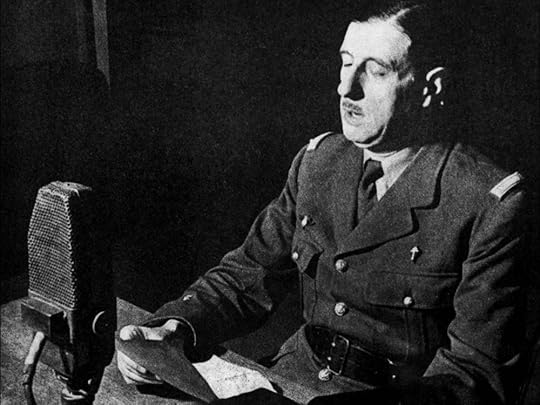
General de Gaulle’s first BBC speech addressing the French
There were, however, problems with the authorities in London because of the General's complex character and often unpredictable temperament. There were also a considerable cultural and political difference between the two governments.
For example, De Gaulle felt nervous about having ties with British intelligence services. To stay in charge of what they "did" in his own occupied country, he ordered them "not to use Frenchmen in operations without his express permission." For SOE, this was a considerable obstacle, both for security and political reasons. If the French agents they sent into France shared De Gaulle's political ideas, what effect could this have on SOEs relations with Petain's Vichy Government?
Until the entire German occupation of France in 1942, SOE agents in France benefited from being able to travel more or less in disguise through the south - non-occupied - part of France.
Though the SOE couldn't 'freely' operate in France without the Gaullist movement, there was a persistent lack of direct co-operation between the Gaulle and the SOE, because of the General's unwillingness to put heads together. The sad part of this ongoing conflict was that it brought SOE agents in France into peril and, sometimes, led to their arrest and their death.
There was another impediment to De Gaulle's refusal to co-operate:
All attempts to build para-military organizations together with Fighting French and with the help of Fighting French personnel failed to come off the ground. Though SOE had the armed men and women to carry out attacks on important French targets, General de Gaulle wasn't - in the first years of the war - unable to deliver, say, 50 (wo)men.
So, was De Gaulle considered the actual leader of the French population fighting the Nazis? How was his relationship with his own secret services? There is much evidence that though French officials considered De Gaulle as important for the War, they didn't expect him to maintain that position after the war. He was just the thorn in the flesh for the time being. How wrong they were!
From London, De Gaulle worked steadily on increasing his influence over the French. He entered relations with leaders of French political groups, hoping to win them over to secure his status as the leader of a post-war French Government. He also maintained relations with the Syndicalism movement, the socialist party, trade unions, with right-wing politicians and had a quid-pro-quo relationship with the strong French Communist Party. All efforts were geared at making him the leader of all French citizens.
The history-long strained relations between France and Great Britain continued to simmer in the attitudes and sentiments of certain groups. The French were unconvinced by Great Britain's willingness to support its security after the war. The US and UK governments were suspicious about the policy direction of De Gaulle’s French Committee of National Liberation (FCNL). The party de Gaulle formed when he moved his headquarters from London to North Africa in August 1943.
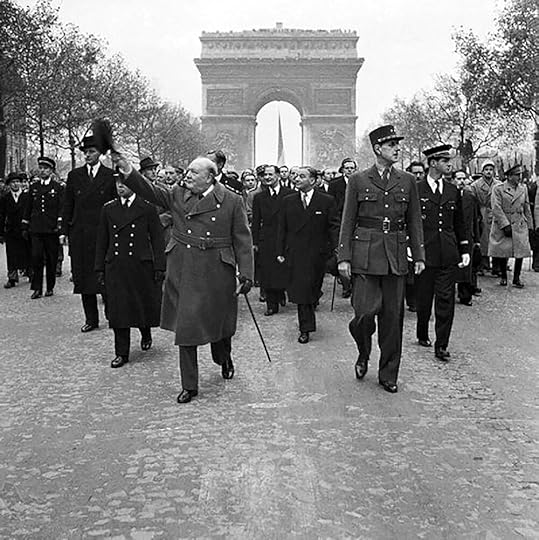
Churchill and De Gaulle in Paris after the war
While the US was generally held in high esteem by the French, Petain seemed to have never understood how the US embassy in Vichy was maintained. The French leftist parties were also unhappy with the rumors of the US supporting French capitalist and conservative groups to facilitate American business interests after the war.
1942 was to see the re-birth of the French Army when the ex-head of the Vichy Armed Forces, Jean Francois Darlan, became high commissioner of French North Africa. The military leadership was taken over by General Henri Giraud in December 1942, after Darlan's assassination. From that moment onward, De Gaulle and Giraud acted as Co-Chairmen of the FCNL. Relations within the FCNL, and with leaders of the Resistance movement, as well as with Giraud's right-wing followers were tightened.
Until Petain’s surrender, France's opinion of the war was one of confusion. Now the cards were on the table and the situation was clear. They were all occupied by Nazi-Germany. However, the number of French citizens directly involved in resistance movements was estimated to be slightly less than one million by 1943, with some two million sympathizers. On a population of 40+ million occupants!
But the fighters were far from united, even in the field. In-fighting, areas under patriotic control and warnings that SOE failed to support the French resistance were commonplace.
The SOE mission and circuit reports showed that the differing political tendencies and subsequent policies were a complicated obstacle to overcome for SOE agents in the field. Landing grounds, locations and SOE activities in liberated areas were hampered by military liaisons within the French Forces, Resistance and Maquis (French resisters).
The London Gaullist organization Bureau Central de Reseignmements et Action et Londres (BCRAL) still acted independently from the SOE Headquarters around the corner.
But it wasn't all De Gaulle's obstruction. The organizational preparation for D-Day and the reluctance of the Allied Forces to allow the Gaullists to take part, shows the deep mistrust between the parties. The Allied Forces (read UK and US) questioned whether some French communist groups may have had independent aims for D-Day.

Charles de Gaulle as the President of the Fifth Republic of France
This blog is just a brief overview of the relations between the French and UK secret services during World War 2. Scholars and historians have studied the archives after they were made public in the early 2000s. Much went wrong, but there is no doubt that both the Free French Movement and SOE were instrumental in making D-Day a success.
Charles de Gaulle briefly became France's president at the end of the war, as he was considered their natural leader but soon resigned due to policy differences. He only became the (famous) President of what he dubbed The Fifth Republic in 1959 and reigned until 1969. His name will be forever tied to WW2 and the French post-war politics.
November 19, 2022
More on my upcoming Victorian Mystery
I’m writing a Christmas book for the first time in my author career and it’s a Victorian Mystery, titled The Unsolved Case of the Secret Christmas Baby. This the first book in The Mrs Imogene Lynch Series, introducing the widow of a Cotswolds’ constable at the end of the 19th century in England.
The book is now on preorder and will be available as an eBook and in print on 6 December. It will also be in Kindle Unlimited. Link(s) below.

Make it stand out
Book description:
A presumed dead baby who's just turned fifty, a grieving widow on a mission, a female haberdasher hiding a scandalous secret
The Cotswolds, England, December 1895
Fifty-year-old Imogene Lynch has recently moved to the tight-knit community of Dartmond after her husband passed away.
In the decades of her husband's job as chief constable of the neighboring Landdulton, the childless Imogene often assisted him in solving seemingly unsolvable crimes. On his deathbed Thaddeus Lynch has one last request to his wife: solve the secret Christmas baby's mystery.
Overcome by grief, but with the promise as a stamp on her heart, Imogene sets out in her roundabout way to unearth Sir Finley Lowther's mysterious origins. The first trace leads to Miss Eloise Platt, a well-respected Dartmond shopkeeper.
But when a baby's skull is dredged up from the bottom of Tiverstock Lake and Miss Eloise confesses to the murder, Mrs Imogene Lynch faces a stalemate. While the Dartmonders squabble over Miss Platt's fate, the widow-turned-detective worries she'll never fulfil her promise.
To break through her impasse, she pays a visit to the elderly Lady Lowther in Ridgeview Asylum with far-reaching consequences. For Imogene, the mystery is now solved, but getting Miss Platt to tell the truth is another matter.
With her characteristic quirky style, Mrs Lynch confides in the most unlikely candidate in her arsenal, her landlord, Mr Richard Hopewell. If the mute bookkeeper can shed light on what he witnessed on that fateful Christmas Day in 1845, she has the ally she needs to confront Miss Platt.
After fifty-one years, Constable Thaddeus Lynch's brown file on the Secret Christmas Baby can be closed for good. With Finley's adoption mystery solved and Miss Platt redeemed, all Dartmond joins in the merry 1896 Christmas celebrations.
This first book in the Victorian Cozy Mystery Series introduces Mrs Imogene Lynch, a willy-nilly detective who talks too much and eats too little.
Preorder here
Here’s the prologue to give you a taster.
Landdulton, January 1895
It is a crisp and frosty morning in early January when Sir Finley Lowther, with swift steps despite his considerable weight, makes his way up the steps to a glass-panelled door that reads Messrs Ephraim Galway & Lambert Watson, Solicitors in ornate, golden lettering. The expression on his broad face, with a well-coiffed moustache and ocean grey eyes, is serious, perhaps even somewhat morose. A visit to one's solicitor is hardly ever a joy.
Taking a moment to catch his breath, he retrieves his golden snuffbox from the pocket of his waistcoat, which is a well-cut garment of excellent quality wool in a pattern of black and white lozenges. The white of the waistcoat is the only exception to his overall, black mourning attire. Finley is in mourning for Sir Reginald Lowther, his father, who passed away peacefully on the first of January.
Sir Finley stops at the top of the steps to take a pinch of the ground tobacco between his stubby fingers, which he pops routinely behind his full underlip. Deftly slipping the box back in place, he pushes the door open with visibly more pep.
The spacious hall with the tiled floor and high, painted ceiling is agreeably warm on this wintry day. Sir Finley presses his card into the waiting bellboy's hand and hangs his overcoat and top hat on the coat rack.
Minutes later, the Squire of Landdulton is seated in one of Mr Galway's mahogany-brown Chesterfield armchairs, crossing his legs in their black trousers, smoothing the creases. Opposite him is seated his long-time friend and hunting partner, Ephraim Galway, with a sympathetic look on his elongated, white face with thin nose and shrewd black eyes. The solicitor seems set on cheering up his best friend but goes about it in the opposite way.
"What a rigmarole your father's will is, Fin. Who'd have thought you might not be a Lowther by birth? Well, you always be one to me, dear friend. Whatever the outcome of Sir Reginald's preposterous claims." The solicitor taps the tips of his slender fingers together making the diamond in his signet ring flash in the electric light.
Finley shifts in his chair, thunderclouds forming in his grey eyes.
"What nonsense are you talking, Efry? For sure, you knew of this change to my father's will!" He looks sour, drops his chewing tobacco in the ashtray and lights a cigar. Then starts puffing on it without offering one to his friend. Ephraim throws his thin arms in the air in protest.
"What distrust, my dear fellow. Have I ever lied to you? Or deceived you? Right after your father apparently told you about your adoption, he ordered me to Gladmers Manor to change his will. He told me you knew about the change but that I had to wait for your visit to me. I was ordered to uphold complete confidentiality. So that's what I did."
The hands go up again, this time as giving himself over to the power of the late Sir Reginald. Finley hesitates, seems to weigh his friend's words against his own experience, then frowns once more.
"All right. Don't work yourself up, Efry. It's quite enough for one of us to be in a pickle."
"You're not in a pickle by any measure, Fin. I know a way around this if you want."
That seems to perk up the squire to some extent.
"Well, you'll have to tell me what's in the will before I can decide on that."
Now it's Ephraim’s turn to pause.
"What do you know, Fin? What exactly did your father tell you? As you can understand, he gave me no details about your birth or this presumed adoption. Just told me to add the clause that it's your duty to find the biological mother and give her ten percent of the inheritance. If you fail to find her, that ten percent has to be given to the Foundling Hospital in Bristol." Here, the solicitor shows his face. "Note, if you fail to find her, you can pay that hospital anonymously, and nobody will ever find out you may have been compromised in some sort of scandal."
"Get me a brandy first. I hear my father's voice again, telling me that exact thing. I hate talking about this business. It upsets me. Not to talk about how much it's upsetting Anna as well."
The solicitor nods, rings the bell, and the liquor is served in a wink by the bellboy.
"Terrible business all around for you and your wife. I don't understand why your father deemed it necessary to confess this adoption history on his deathbed."
"Oh, he wanted to die with a clean conscience," Finley observes, sipping his drink. “You know how my father was. A lot of wool-gathering and mystifications, but when it came to the crunch, he wanted to die with a clear conscience about what he'd done. And amend for it in his own way."
"So, what did he do?" The solicitor is getting impatient, leaving his own drink untouched.
Finley smiles a thin smile. "I wish I knew. The desire for mystifications never completely evaporated. But apparently my insane mother, you know Lady Lowther, who's been in Ridgeview Asylum for decades and is never talked about in the family anymore, is not my biological mother. She only had my sister Catherine, but where I exactly came from and whether my father was my biological father, he didn't want to disclose for privacy of the biological mother. Can you imagine?" Finley's eyes get the turbulent ocean quality again. "He knew, but he wouldn’t tell me. Just barked at me to get Constable Lynch involved as he's my brother-in-law and has access to archives that might help find the mother. Have you ever heard of such nonsense? And you know what is the rottenest thing of all? My father seemed to know where to find this woman, but he clearly wanted to saddle me with his last mystery. Well, he liked those things. I don't." Finley is fuming with anger now while Ephraim looks pensive.
"Think of it this way. Your father might have had a good reason not to disclose the woman's identity. Have you considered asking Lady Lowther herself?"
Finley sits up straighter, still angry. "Are you mad, Efry? No one goes to Ridgeview Asylum. She's not been seen since I was born. I don't even know her. And I have no longing to change that."
Ephraim sits back in his chair, the fingertip-touching starting again. "But your brother-in-law is terribly ill himself. How can he undertake such a case now?"
"Exactly!" the squire exclaims, finishing his drink and banging the crystal glass back on the ivory tray. "I don't want Thaddeus to break his head over it, but it's too late. Anna apparently told Imogene and Thaddeus is now frantically trying to get the evidence together by going into the archives of what happened at Christmas in 1845, when I was born."
"Imogene, being your cousin, just wants to help you," the solicitor offers.
"Yes, of course she does. And that's all well and good, my entire family getting involved, but I'm not sure I want to rake up this old history. It's not like I'm suddenly bereft with no mother in my life - I haven't had a mother, biological or adopted for 50 years." Finley looks gloomy.
"Is it perhaps the inheritance you don't want to share?" The solicitor’s black eyes rest on his friend.
"God, man, no. That's the least of my concern. It's not like I'll be a pauper if I give away some of my money. It's this emotional thing I hate - digging up scandal and drama when it is all decades old and serves no purpose."
It is silent in the solicitor's office for a while. Finley puffs on his cigar and Ephraim studies his fingernails.
"So, what will you do now?" The solicitor is the first to speak. "I told you you can pretend to find her and then just pay the money to that hospital for unwed mothers?"
"And I told you I don't care about the money." Finley snaps, easing himself out of the deep chair. "Let me think about it. I came here hoping you knew more about this rigmarole, but apparently you only got the will. It's all right, Efry, really it is. I'll sort this out myself and will let you know one way or the other."
Ephraim rises to his full length as well, a frown in between his eyes. "I'm so sorry for all this, Fin. Certainly so soon after your father's passing and with your brother-in-law being so ill. You're going through a rough period. Will you be at the Club this Thursday?"
The men shake hands, still the best of friends.
"Of course, the Club's the only bright spot in my miserable existence right now. See you for a proper game of billiards on Thursday night, and make sure you let me win to improve my mood."
"Done deal, friend. All the best."
Preorder here
November 6, 2022
Klaus Barbie: From Nazi Criminal to Post-war US Spy
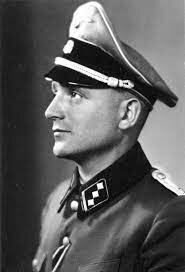
The “butcher of Lyon”
Introduction
When reading this blog post, I guess your hairs will start to stand on end just like mine did. Some criminals seem able to escape justice for a very long time. But not eternally! In Barbie’s case, we need to thank the Nazi-hunting couple Serge and Beate Klarsfeld and journalist Ladislas de Hoyos, who managed to bring his truly dangerous man to justice for a French court after 33 years in freedom.

Serge and Beate Klarsfeld in the 1970s
Who was Klaus Barbie?
Nikolaus "Klaus" Barbie (25 October 1913 – 25 September 1991) was a German Nazi who worked in both the Stutzstaffel (SS) and the Sicherheitsdienst (SD) and was mainly stationed in Lyon in Vichy France during World War II.
His nickname was the "Butcher of Lyon", because he personally tortured prisoners, mostly French Jews and Resistance fighters, in his function as head of the Lyon Gestapo. Barbie was one of the prominent Nazis who escaped prosecution for many decades, the wry fact being that he was helped to escape by the US.
After the war, United States intelligence services employed Barbie to help them with their anti-communist efforts and stationed him in Bolivia, where he advised the regime on how to repress opposition through torture. Much later the United States issued a formal apology to France for heling Barbie to escape.
But the sad saga doesn't end here. In Bolivia, West German Intelligence Service recruited him as well. There is reason to believe Barbie was deeply involved in the Bolivian coup d'état by Luis García Meza in 1980.
After Meza's fall, Barbie lost the protection of the La Paz government and in 1983 he was - finally- brought to justice in France in a much-televised court case. Barbie was convicted of crimes against humanity and sentenced to life in prison. He had been sentenced to death in absentia both in 1947 and in 1954 but as capital punishment was abolished in France in 1981, it was changed to a life sentence. He died of cancer in prison in 1991, at age 77.

Hôtel Terminus, headquarters of the Lyon Gestapo. Mentioned in The Highland Raven
Second World War
After the Nazis occupied Holland in 1940, Barbie was stationed to Amsterdam. His department was responsible for identification, roundup and deportation of Dutch Jews and Freemasons.
In 1942, he was sent to Dijon in the French Occupied Zone. In November 1942, at only 29, he was made head of the Lyon Gestapo. His headquarters were at the illustrious Hôtel Terminus in Lyon, where he personally tortured both adult and child prisoners. Early on this les to his alias the "Butcher of Lyon".
It is estimated that Barbie was directly involved in the deaths of up to 14,000 people, personally participating in roundups. His most famous victim was Jean Moulin, a high-ranking member of the French Resistance. In 1943, Barbie was awarded the Iron Cross (First Class) by Adolf Hitler for rounding up to many members of the French Resistance and for capturing and killing Moulin.
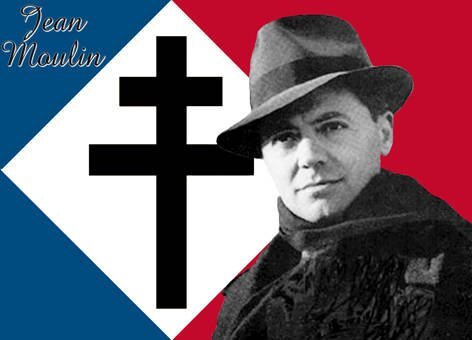
Jean Moulin, the flamboyant and fearless French resistance fighter who died under Barbie’s hands.
But he is also responsible for many of the roundups and deportations of Jewish adults and children who were mostly deported to Auschwitz. Barbie rejoined the SiPo-SD of Lyon when the Nazis had to retreat and led an anti-partisan attack in September 1944.
US intelligence work in post-War Europe
While still in Germany, Barbie was recruited as an agent for the US Army Counterintelligence Corps (CIC) in 1947. The US used Barbie and other Nazi Party members for its anti-communist efforts in Europe. He reported on French intelligence activities in the French zone of occupied Germany as the US suspected the French were infiltrated by the KGB and GPU.
When France found out Barbie was in U.S. hands, although he had been sentenced to death in absentia for war crimes, they unsuccessfully asked for him to be handed over for execution. Instead, the CIC helped Barbie flee to Bolivia, claiming Barbie had too much knowledge about the German spies the CIC had in various European communist organisations.
In 1965, Barbie was recruited by a West German foreign intelligence agency under the code name 'Adler', which means eagle.
Bolivia
In 1951 Barbie emigrated to Bolivia where he lived for over 30 years under the false name Klaus Altmann. Barbie was found there in the higher echelons with friends like the Bolivian dictators Hugo Banzer and Luis García Meza. He was still the German nationalist and anti-communist he'd been from the start. While in Bolivia, he raised to the rank of lieutenant colonel in the Bolivian Army.
Barbie taught Barrientos's regime how torture can best be employed on prisoners. Many left-wing Bolivian groups suffered from Barbie's instructions on how to use intelligence, torture, and interrogations. From 1972 when General Banzer was in power, he assisted in illegal arrests, interrogations, murders and disappearances of the opposition.
Barbie was also linked to neo-Nazi paramilitary groups in Bolivia and drug cartels, including illegal drug and weapon trade. In the late 1970s, Barbie also had liaisons with the Columbian Pablo Escobar and others within the Medellín cartel. Escobar financed Barbie's anti-communist activities. He also stayed in touch with Nazis and Fascists in his native Germany, thus staying involved criminal and anti-democratic movements in Europe.
Barbie was also involved in the arrest of freedom fighter Ernesto Che Guevara in Bolivia, who rose to fame in the Cuban Revolution in 1966. Barbie was called in by Bolivian Interior Ministry for his anti-partisan skills. He, apparently often boasted of having "hunted down Che".

The world-famous picture of left-wing politician and poet Che Guevara
There are many records that state Barbie remained a firm and fanatic believer in the Nazi ideology and was a staunch anti-Semite. He also introduced Josef Mengele's and Adolf Eichmann's practices, which Barbie fully supported and saw as the norm for dealing with opponents.
The tide is turning
Th French Nazi hunters Serge and Beate Klarsfeld found out Barbie, alias Altmann was in Peru in 1971. The French newspaper L'Aurore published an article with a picture of Altmann in January 1972. A German expatriate living in Lima had provided the Klarsfelds with that photo. Barbie was in Peru to provide intelligence services to the Velasco junta.
Together with Beate Klarsfeld, a French journalist and cameraman flew to La Paz to interview Klaus Barbie, alias Klaus Altmann. The Bolivian authorities had placed Barbie under protection, but he agreed to an interview in Spanish. The journalist, Ladislas de Hoyos, tricked Barbie by asking in French whether he'd ever been to Lyon, a language Altmann wasn't supposed to understand. Barbie's automatic response in German was that he hadn't.
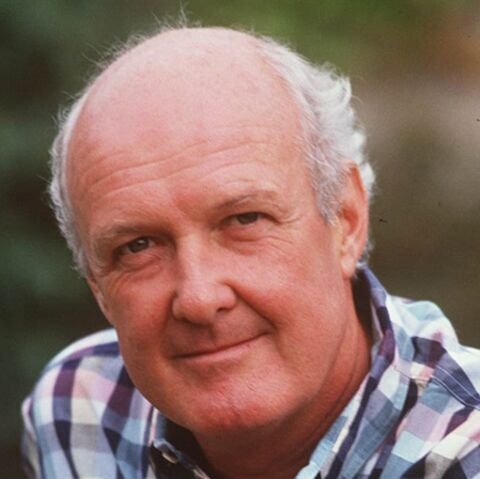
Journalist Lasdislas de Hoyos at a later age
Ladislas de Hoyos then showed him pictures Resistance fighters he'd tortured. Barbie again replied to the negative, but his fingerprints were on the photos now and with the new technology point betrayed him. The third evidence against him was when the interview was broadcast on French television, Barbie alias Altman was recognized by French resistance member Simone Lagrange whom he had tortured in 1944 when she was only 13.
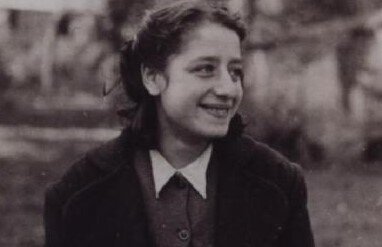
Simone Lagrange before being tortured by Barbie and deported to Auschwitz with her family
Despite global outcry, Barbie freely returned to Bolivia where the government refused to hand him over to the French authorities as France and Bolivia had no extradition treaty and the statute of limitations on his crimes had passed. Barbie's inner circle of fascists knew exactly who he was and what he'd done in WW2, but outwardly Barbie continued to portray himself as the innocent Altmann.
However, the tide was turning against him in the 1970s. The Jews who had survived or escaped the war started to open discussed that Barbie/Altmann was the war criminal from Lyon now living in La Paz, here he led a coveted life protected by the Bolivian regime.
Barbie's extradition, trial and death
It took until 1983 when the newly elected democratic government of Hernán Siles Zuazo arrested Barbie in La Paz. The pretext was that he owed the government an exorbitant sum for goods he'd never delivered. The government subsequently handed him over to France to stand trial.

Klaus Barbie during his trial
Shortly after his arrival in France, the evidence of Barbie having worked for US intelligence in Germany became also known, including the fact that the US very well may have helped Barbie to flee and thus escape French justice for 33 years. The US Counterintelligence Corps (CIC) claimed it had no knowledge of Barbie's atrocities in Lyon during WW2, but it was still US self-preservation to help Barbie escape Europe rather than honour an outstanding French warrant for his arrest. Based on the research that took place, the US government issued a formal apology to France.
Barbie was indicted for crimes he had committed as the Lyon Gestapo chief from 1942 to 1944. The jury trial started in May 1987 in Lyon before the Rhône Cour d'Assises. It was one of the first times the court allowed the trial to be filmed due to its historical value. A special courtroom was constructed with could seat 700 people. The head prosecutor was Pierre Truche. Central issue was Barbie's role in Hitler's Final Solution.
Barbie's defence was financed by Swiss pro-Nazi financier François Genoud and led by attorney Jacques Vergès. Barbie was tried on 41 separate counts of crimes against humanity, based on the depositions of 730 Jews and French Resistance survivors who described how he tortured and murdered prisoners. Among his victims was the father of French Minister for Justice, Robert Badinter had died in Sobibor after being deported from Lyon on Barbie's orders.
Barbie continued to claim he was Klaus Altmann and that the extradition was illegal. Asking to be excused from the trial, he was allowed to return to his cell at Prison Saint-Paul. He faced some of his accusers at the end of May 1987. To their testimonies he had "nothing to say".
Barbie's lawyer, Vergès, was well versed in attacking the French political system, especially when it came to the French colonial past. His strategy was to show war crimes committed by France since 1945. Vergès argued that Barbie's actions were no worse than the actions of other colonialists worldwide, and that his trial was based on selective prosecution. Barbie continued to believe in his innocence, claiming "When I stand before the throne of God, I shall be judged innocent."
But the court thought otherwise. On 4 July 1987, Barbie was convicted and sentenced to life imprisonment. He died in the Lyon prison four years later of leukaemia and spine and prostate cancer. He was 77.
Personal life
In April 1939, Barbie became engaged to Regina Margaretta Willms, the 23-year-old daughter of a postal clerk and an active NSDAP member; they had two children. A son named Klaus-Georg Altmann and a daughter named Ute Messner.
Françoise Croizier, Klaus Barbie's French daughter-in-law, told in an 1983 interview that the CIA kidnapped Klaus-Georg in 1946 to make sure his father carried out intelligence missions for the agency. Croizier met Klaus-Georg while both were students in Paris; they married in 1968, had three children and lived in Europe and Bolivia using the surname Altmann. Croizier said when she married, she did not know who her father-in-law was, but that she understood the reasons for a German to move to South America after the war.
October 23, 2022
I’m branching out into Victorian Mysteries

I’m super thrilled to let you know my first Victorian Mystery is up for preorder. The Unsolved Case of The Secret Christmas Baby comes out on 6 December. It’s the first book in The Mrs Imogene Lynch Series, featuring the widow of a Cotswolds constable in the late 19th century. Mrs Imogene Lynch needs to solve the last case her husband was unable to finish.
Does it taste for more to Imogene?
We’ll see.
Here’s the description for the first book:
A presumed dead baby who's just turned fifty, a grieving widow on a mission, a female haberdasher hiding a scandalous secret
The Cotswolds, England, December 1895
Fifty-year-old Imogene Lynch has recently moved to the tight-knit community of Dartmond after her husband passed away.
In the decades of her husband's job as chief constable of the neighboring Landdulton, the childless Imogene often assisted him in solving seemingly unsolvable crimes. On his deathbed Thaddeus Lynch has one last request to his wife: solve the secret Christmas baby's mystery.
Overcome by grief, but with the promise as a stamp on her heart, Imogene sets out in her roundabout way to unearth Sir Finley Lowther's mysterious origins. The first trace leads to Miss Eloise Platt, a well-respected Dartmond shopkeeper.
But when a baby's skull is dredged up from the bottom of Tiverstock Lake and Miss Eloise confesses to the murder, Mrs Imogene Lynch faces a stalemate. While the Dartmonders squabble over Miss Platt's fate, the widow-turned-detective worries she'll never fulfill her promise.
To break through her impasse, she pays a visit to the elderly Lady Lowther in Ridgeview Asylum with far-reaching consequences. For Imogene, the mystery is now solved, but getting Miss Platt to tell the truth is another matter.
With her characteristic quirky style, Mrs Lynch confides in the most unlikely candidate in her arsenal, her landlord, Mr Richard Hopewell. If the mute bookkeeper can shed light on what he witnessed on that fateful Boxing Day in 1845, she has the ally she needs to confront Miss Platt.
After fifty-one years, Constable Thaddeus Lynch's brown file on the Secret Christmas Baby can be closed for good. With Finley's adoption mystery solved and Miss Platt redeemed, all Dartmond joins in the merry 1896 Christmas celebrations.
This first book in the Victorian Cozy Mystery Series introduces Mrs Imogene Lynch, a willy-nilly detective who talks too much and eats too little.
Coming 6 December 2022 Preorder hereWant to get to know Mrs Imogene Lynch? Click here to read the free story The Disappearance of Miss Phoebe Hewlett.
I’m branching into Victorian Mysteries

I’m super thrilled to let you know my first Victorian Mystery is up for preorder. The Unsolved Case of The Secret Christmas Baby comes out on 6 December. It’s the first book in The Mrs Imogene Lynch Series, featuring the widow of a Cotswolds constable in the late 19th century. Mrs Imogene Lynch needs to solve the last case her husband was unable to finish.
Does it taste for more to Imogene?
We’ll see.
Here’s the description for the first book:
A presumed dead baby who's just turned fifty, a grieving widow on a mission, a female haberdasher hiding a scandalous secret
The Cotswolds, England, December 1895
Fifty-year-old Imogene Lynch has recently moved to the tight-knit community of Dartmond after her husband passed away.
In the decades of her husband's job as chief constable of the neighboring Landdulton, the childless Imogene often assisted him in solving seemingly unsolvable crimes. On his deathbed Thaddeus Lynch has one last request to his wife: solve the secret Christmas baby's mystery.
Overcome by grief, but with the promise as a stamp on her heart, Imogene sets out in her roundabout way to unearth Sir Finley Lowther's mysterious origins. The first trace leads to Miss Eloise Platt, a well-respected Dartmond shopkeeper.
But when a baby's skull is dredged up from the bottom of Tiverstock Lake and Miss Eloise confesses to the murder, Mrs Imogene Lynch faces a stalemate. While the Dartmonders squabble over Miss Platt's fate, the widow-turned-detective worries she'll never fulfill her promise.
To break through her impasse, she pays a visit to the elderly Lady Lowther in Ridgeview Asylum with far-reaching consequences. For Imogene, the mystery is now solved, but getting Miss Platt to tell the truth is another matter.
With her characteristic quirky style, Mrs Lynch confides in the most unlikely candidate in her arsenal, her landlord, Mr Richard Hopewell. If the mute bookkeeper can shed light on what he witnessed on that fateful Boxing Day in 1845, she has the ally she needs to confront Miss Platt.
After fifty-one years, Constable Thaddeus Lynch's brown file on the Secret Christmas Baby can be closed for good. With Finley's adoption mystery solved and Miss Platt redeemed, all Dartmond joins in the merry 1896 Christmas celebrations.
This first book in the Victorian Cozy Mystery Series introduces Mrs Imogene Lynch, a willy-nilly detective who talks too much and eats too little.
Coming 6 December 2022 Preorder hereWant to get get to know Mrs Imogene Lynch? Click here to read the free story The Disappearance of Miss Phoebe Hewlett.
October 15, 2022
Le Manoir: A School Memory in Pictures

“Le Manoir” was a real finishing school in Switzerland before World War 2.
I used the school as the meeting point for my heroines in The Resistance Girl Series. It was here in Lausanne, on the shores of Lake Geneva, where they met up before the war.
Lili, Océane, Esther, Sable and Anna all ‘suffered’ at the hands of the strict schoolmistress, Madame Paul (Vierret), whom they secretly called the Sphinx.
But was she really that bad? At some point, I will tell you Madame Paul’s own story.
But for now, I’m happy to offer you this booklet with photos from the real “Le Manoir”.
I received these photos when I had already written some of the books so in my writer’s brain the school looked very different from reality, but that doesn’t matter one bit.
Take a trip down memory lane. Click on the image or the button.
Download Le Manoir
October 8, 2022
The French Riviera under Italian Rule during WW2

Introduction
During World War 2, the south-eastern part of France was occupied by Fascist Italy from June 1940 until the Armistice between Italy and Allied armed forces on 8 September 1943. The Germans forced the Italian troops stationed on French soil to retreat within their own borders. The Italian occupation of southern France took place during two periods, one in June 1940 and one in November 1942.

The Italian Occupation
Benito Mussolini's invasion of France started on 10 June 1940 with marginal success on the side of Italy. After France's surrender to Germany on 25 June, France and Italy signed an Armistice, in which they agreed on an Italian zone in south-eastern France. This initial zone was some 830 km² and had almost 30,000 French citizens. The largest town in occupied territory was Menton, which became part of the Kingdom of Italy. The main cities lying in the 50-km 'demilitarized zone' from the then border of the Italian Alpine Wall were Grenoble and Nice.
A further increase in territory took place in November 1942, when Nazi-Germany took charge of most of Vichy France, which up till ten had been a French Puppet state led by Marshal Pétain. This military occupation went by the name of 'Case Anton'.
The Royal Italian Army took control of Toulon and the Provence up to the river Rhône. Corsica was also claimed by the Italians. The idea was to annex Nice and Corsica to Italy, just like Menton in 1940, but the Italian surrender to the Allied forces in September 1943 led to the end of the Italian reign in France.

Secret signing of the Cassibile armistice on 3 September 1943
Major General Walter Bedell Smith for the Allies and Brigade General Giuseppe Castellano for Italy
The Italian Army
The Italian occupational army was 700,000 troops strong in June 1940. Though they outnumbered the French in numbers, they had several problems. Their tanks were too light and unsuited for modern warfare. They lacked artillery and motor transport and, most importantly, the Italians were ill-equipped for the cold Alpine climate. The French had created large fortifications along the Alpine Line, which they called the 'Little Maginot'.
The Italian occupation of the larger part of southern France and Corsica in November 1942 faced no opposition from the Vichy Army.
Until the summer of 1943 guerrilla war against the Italian occupation was almost non-existent.
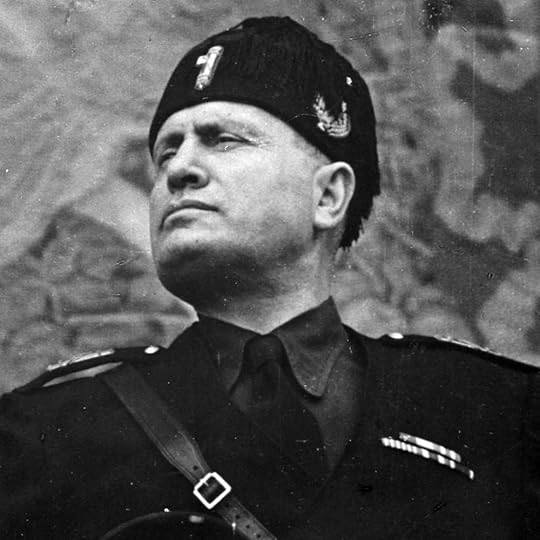
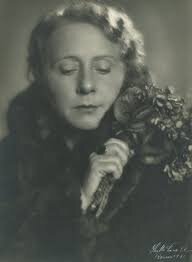
Benito Mussolini and his Jewish mistress Margherita Sarfatti, who was instrumental in shaping Italian “fascism” without the “Jew hate”.
A 'Safe' Haven
In the early years of WW2, thousands of French (and European) Jews fled to the Italian occupied territory of France to escape the Nazis in Vichy France. When the Italians took over more French territory in November 1942, almost 80% of French Jews still in France (300,000) took refuge there. Mussolini never shared Hitler's vision of the "Jewish problem". It is said that one of the reasons Mussolini was not anti-Jew was because he had a Jewish mistress, Margherita Sarfatti.
An Italian Jewish banker, Angelo Donati, played an important role in persuading the Italian civil and military authorities to protect the Jews from the French persecution.
In January 1943 the Italians even refused cooperation with the Nazis to round up the Jews living in their occupied territory. In March they stopped the Germans from deporting Jews from their zone. This led to Joachim von Ribbentrop, the German foreign minister, complaining to Mussolini that "Italian military circles... lack a proper understanding of the Jewish question."
Alas for the Jewish population, after Italy signed the armistice with the Allies in September 1943, the Nazi troops immediately took control of the Italian zone and the raids against the Jews began. Alois Brunner (see below), the SS official for Jewish affairs, led the search for hiding Jews. He had over 5,000 Jews deported within five months.
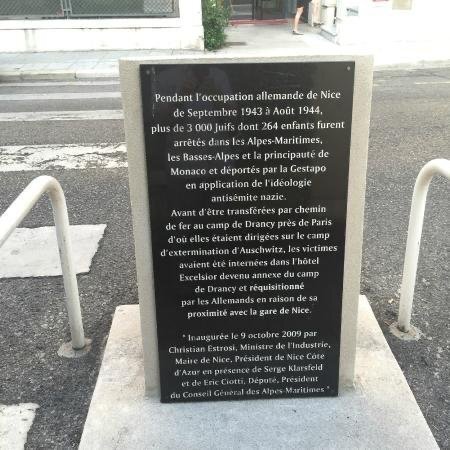
The memorial plaque on the Boulevard
The memorial plaque across the street from Hotel Excelsior
When secret agent Sable Montgomery in The Highland Raven, starts her mission as an SOE agent in occupied France, she arrives from Gibraltar in a felucca on the French Riviera. She stays at the Excelsior Hotel in Nice.
This part of the book takes place at the beginning of 1943 when the Côte d’Azur was still under Italian rule. While doing research, I stumbled upon the chilling history of the Hotel Excelsior when it came under German occupation later that year.
Today, the magnificent Belle Époque hotel with its four stars and perfect location in the city center and near the Mediterranean, is a happy hub where tourists come to enjoy the sunshine and the lavish French Riviera.
But across the street from the hotel, a commemorative plaque reveals a horrendous WW2 tale that would squelch all yearning for summer delights. The story of what purpose this hotel served under the notorious Nazi war criminal Alois Brunner.
When France fell in June 1940 and France was divided between the German-occupied North and the Vichy puppet Government in the south, Nice was in the unoccupied zone. Despite the anti-Jewish legislation the Vichy regime put in place, the Riviėra became a safe haven for Jewish refugees who fled the Nazis. As stated above.
In 1942 the Allies invaded North Africa and the Germans and Italians also occupied the south France. The Riviera was part of Mussolini’s territory. Though certainly no philanthropist, Il Duce didn’t want to collaborate with the Vichy regime and refused to persecute Jews or even to force them to wear yellow stars.
But when Italy surrendered on 8 September 1943, the Germans took over the region where Nice ws. Only two days later the Adolf Eichmann top aide, Alois Brunner, established his headquarters at Hotel Excelsior. It was the beginning of one of WW2’s most atrocious raids against the Jewish population.
Systematically SS officers patrolled the city and arrested everyone that looked remotely Jewish. People of mixed marriages, certain nationalities, children, old people, invalid people, they were all rounded up, interrogated at the hotel and subsequently deported to death camps from the nearby train station.

Alois Brunner
It was only 80 days later that Brunner left Nice again and in that period he had over 2,000 Jews sent to their deaths.
While the Wehrmacht was already retreating from France, Brunner had 1,327 Jewish children arrested and deported in Paris between in July 1944. He left Paris on August 17, a week before the liberation of the French capital, on the last train from the Drancy transit camp with deported people personnel. Brunner's intention was to use the deportees as potential hostages.
In total Brunner had an estimated 23,500 Jews deported from France to the death camps. From September 1944 to March 1945 he extinguished the Jewish underground movement in Slovakia and headed the Sereď concentration camp, from where he had approximately 11,500 people deported to Auschwitz, Sachsenhausen, Bergen-Belsen, and Terezín for extermination.
Alois Brunner is one of the top Nazis who managed to escape after the war and always remained free. He allegedly died in Damascus around 2010.

Today’s Hotel Excelsior looking all innocent
Modern-day Hotel Excelsior
The Hotel Excelsior plaque was inaugurated by the mayor Christian Estrosi in 2008. In his speech he said that the hotel today still bears the traces of Jewish suffering. All those innocent man, women and children who thought Nice would be a safe place.
October 2, 2022
The Highland Raven is Live!

I’m extremely happy and proud to announce that the 5th book in my Resistance Girl Series went live on Tuesday 27 September as an eBook and paperback. The Highland Raven is finally here!
It’s been a long wait for the readers (8 months) and a work of love and labour for me. At least 1,000 hours of research, a research trip to the Beaulieu Spy museum in the UK and many rounds of writing, edits and revisions. 464 pages of action, heartbreak, suspense and a happy end!
Here are some of the first reader reactions:
“This book is brilliant. It fits in with the others like a very satisfactory jigsaw puzzle. Loved them all.”
“Ms. Byron sets the scene beautifully with her writing. As with previous books, the descriptions make me see the surroundings clearly in my mind. The book has suspense, grief, and luckily, a happy ending for Sable. I recommend this book for mature readers.”
“The Lady is a true fighter. This is book 5 of the Resistance Girl Series and Hannah Byron has outdone herself yet again! This is a must read if you love historical fiction during war time.”
“Lovely book set before, during and slightly after WWII.”
Learn MoreSeptember 24, 2022
Oswald Mosley & the British Union of Fascists

Sir Oswald Mosley (16 November 1896 – 3 December 1980), the most notorious British Fascist
Though Mosley’s Fascist Party doesn’t really play an important part in my new Resistance book, The Highland Raven, I think this is a part of pre-war British history that isn’t as well-known. Moreover, this man and his wife, hung on to their preposterous belief systems all their lives.
Introduction
Since he launched his British Union of Fascists, Sir Oswald Mosley has been considered Britain’s most well-known fascist. He was staunchly anti-Semitic and friends with the likes of Adolf Hitler and Benito Mussolini. What's more, he remained a fascist until he died near Paris on 3 December 1980.
Childhood
Sir Oswald Ernald Mosley was the eldest son of a baronet, born in a London aristocratic family in Mayfair, London, on 16 November 1896. He enjoyed a privileged upbringing, educated at Winchester College and then at the Royal Military College at Sandhurst. He was an excellent fencer and boxer.
Considered odd by many of his peers at school, Mosley had few friends and was expelled from Sandhurst after just six months, following a fight with another student. Reportedly, this was related to the defeat on the polo field by the rival military academy Aldershot.
Mosley's Political Rise to Power
Oswald Mosley was the House of Commons’ youngest member when he took his seat in 1918 at the age of just 22 as the Conservative MP for Harrow. He had served in the World War I in the Royal Flying Corps and the 16th Lancers, before working in the Ministry of Munitions and the Foreign Office.
Not long after being elected, Mosley became disillusioned with the Conservative party. In 1922 and 1923 he was re-elected in Harrow as an Independent, but then joined the Labour party in 1924, thus seeing both sides of the House of Commons.
In the early 1930s, Mosley's star was rising under the Labour Prime Minister Ramsay MacDonald. As Chancellor of the Duchy of Lancaster (a minister without a portfolio), his job was to deal with the unemployment crisis caused by the 1929 Wall Street Crash. Almost three million people eventually became unemployed in the UK.
Averse to adopting what he considered 'an orthodox deflationary response' to the economic crisis, Mosley instead proposed public work schemes and the nationalization of primary industries. However, the Cabinet found this “very dynamic and interventionist approach” rather too radical and rejected it. Mosley, furious and disappointed, saw no other route than to resign from the cabinet, which he did in May 1930.
The New Party
Soon after, he established the New Party, which became the predecessor of the British Union of Fascists. Combining an odd mix of radical left and conservative right members, it flopped. New Party meetings were often disrupted by Communists who ferreted out the party's “incipient fascism”, but also by Labour party members who felt betrayed by Mosley. The violence and thuggery of the so called ‘Biff Boys’, Mosley's bodyguards, set the tone for the New Party. In the BUF, these bodyguards would become known as Mosley’s Blackshirts.
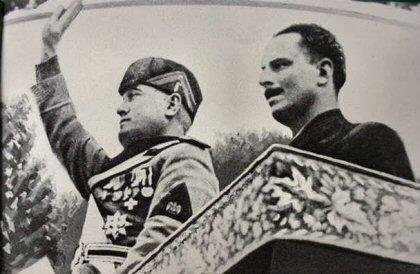
Benito Mussolini and Oswald Mosley
When the New Party didn't take off, Mosley visited Italy to meet with Benito Mussolini, the Italian fascist dictator, Il Duce. Impressed by the Republican Fascist party and its leader, Mosley founded the British Union of Fascists on his return to England. It was modeled on Mussolini’s party system.
The British Union of Fascists
The BUF was officially established by Mosley in October 1932. It disbanded in May 1940, at the end of the Phoney War, so was active throughout most of the 1930s.
The BUF immediately established itself as a radical, dynamic counter-force to the conventional political parties governing Britain. To display that strive was necessary to make change possible, the BUF members chose a paramilitary style, such as Blackshirt uniforms inspired by Mussolini’s forces. Mosley's men, however, donned a fencing-type tunic as uniform.
They introduced the fascist salute, the right arm extended, like other fascist groups on the Continent. The ‘fasces’ became the BUF' symbol (a bundle of wooden rods and an axe held together by leather thongs), very like Mussolini's symbol. Later he replaced it with the lightning flash in a circle, to express action and unity.
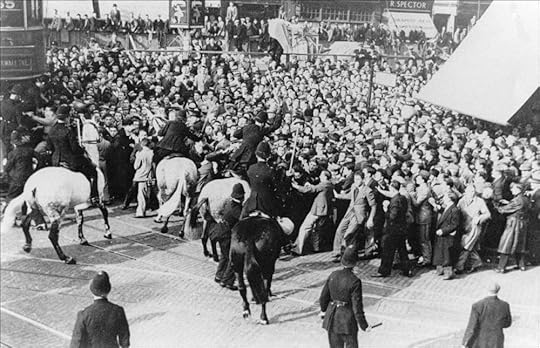
A BUF March
The BUF became renowned for its marches, meetings, and public rallies. Towards 1934, these events attracted substantial crowds, for example in the Olympia in London, Albert Hall, Hyde Park, and Belle Vue Gardens in Manchester.
The meetings were often met with resistance from anti-fascist movements. Especially, the rally at Olympia in London in 1934 led to a clash, with the Blackshirts resorting to horrible and uncalled-for violence.
After Olympia, the attitude of the public changed, based on the press coverage of the outrageous behavior of Mosley's bodyguards. But this didn't stop the BUF. On the contrary, it had found its footing and adopted a militant anti-Semitic attitude of intimidation, harassment, and violence against British Jews, particularly in the East End. That part of London housed around 100,000 Jews at the time.
In October 1936, after Mosley had announced a march through the East End, some 200,000 people gathered to try to prevent it by forming a human barricade at Gardiner’s corner and erecting barricades at Cable Street. The clash that resulted between anti-fascists and the police forced Mosley to abandon the march.
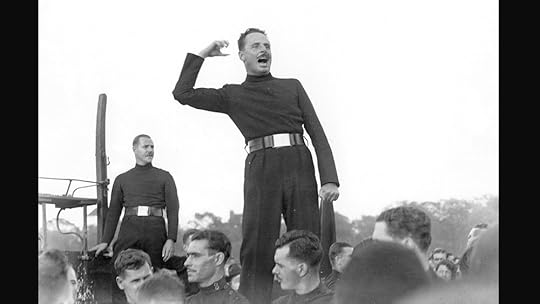
Mosley at the Olympia Rally
Anti-Semitism was a key aspect of the BUF’s ideology, in line with Hitler's ideology but different from Mussolini's, who never was an anti-Semitist. There was a difference between the BUF's anti-Semitism and that of the Nazis, though, as Mosley adhered more to a form of conspiratorial cultural anti-Semitism instead of the racial anti-Semitism prevalent in Germany.
As far as the BUF's economic and political ideas were concerned, they were mainly a reaction to the Great Depression. Mosley believed in a ‘corporate state’, a parliament based on an occupational franchise rather than an electoral franchise. Each industry was to be organised in a corporation, providing a partnership between employers and employees. Over and above that, Mosley’s fascist government would rein, answerable only to the king. It was to be a form of ‘modern dictatorship’ with some input from the people.
The BUF's Popularity
In the early years, the BUF grew fast and had a substantial support, also thanks to Lord Rothermere, the owner of the Daily Mail, who sponsored the party lavishly. In January 1934, he published the infamous article “Hurrah for the Blackshirts!” With Rothermere’s help, BUF grew to 50,000 members in 1934.
After the violent Olympia Rally in the autumn of 1934, Rothermere withheld with support and by the end of 1935, the BUF had only some 5,000 members. After the declaration of war on Germany in September 1939, the party grew again to around 22,500 members, largely because the BUF supported the anti-war appeasement.
They were never large enough electorally to have a seat in Parliament, though they had some local successes.
The BUF's connection to the fascist regimes in Germany and ItalyMosley's closest ally was Mussolini. On his visit to Italy in April 1933, he was given the honour of a 100,000-strong Blackshirt parade. After 1934, the BUF also received a substantial subsidy from Mussolini's government.
Mosley anti-Semitic speeches were praised by Hitler. This is a 1935 telegram Mosley sent to Hitler as a response to his,
“Please receive my greatest thanks for your kind telegram in relation to my speech in Leicester, which was received while I was away from London. I esteem greatly your advice in the midst of our hard struggle. The forces of Jewish corruption must be overcome in all great countries before the future of Europe can be made secure in justice and peace. Our struggle to this end is hard, but our victory is certain.”
Like Hitler, Mosley had found his scapegoat for all that was wrong in society in the form of the Jewish population. Anti-Semitism became the essence of Mosley’s manifesto.
By 1937, Mussolini had become less in favour of Mosley's leadership and the subsidy was withdrawn. It meant the need for major cuts at the BUF’s London headquarters. The Northern Command HQ was closed, and several leading officials were dismissed. It also meant Mosley became even more reliant on Nazi-Germany.
After the party was rebranded to the British Union of Fascists and National Socialists in 1936, funds from Berlin trickled in, but they were substantially less than Mussolini's subsidy. On theory is that Hitler saw Mosley as more of a thinker than a doer.
Oswald Mosley as leader
Mosley created his image carefully. He took a stance as the quintessential new fascist man, charismatic, flamboyant, virile, athletic, supremely masculine, and a skilled orator.
This image contrasted with the so-called feminised and decadent political classes in power in Britain in the 1930s. The leadership cult built around Mosley as the man-in-charge was an important part of the party culture.
The British that joined the British Union of Fascists
A motley social group was attracted by the BUF. In London's East End, these were mainly groups of working-class men that weren't members of unions, but there were also many middle-class supporters. The paramilitary display appealed in particular to young men. Some 75% was male, 25% female.
Initially, when supported by the Daily Mail, middle-class people considered Mosley as a leader who would offer them a dynamic form of conservatism, an alternative for the Conservative party. But the rise of anti-Semitist propaganda drew a different audience to the BUF, certainly in the East End. Towards the end if the 1930s, the support was more middle class again, following the appeasement, anti-war policy.
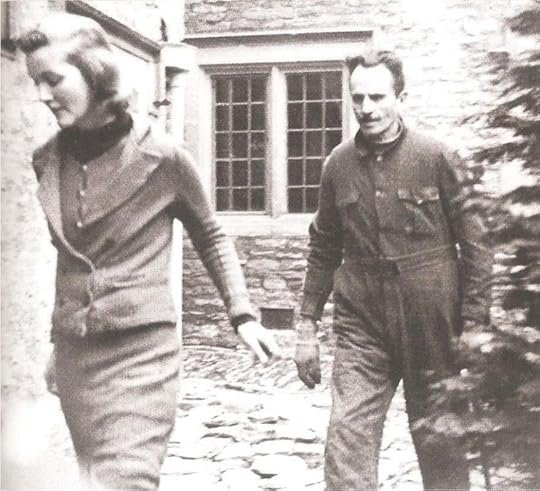
Mosley and Diana during their prison years
The Disbandment of the BUFAfter the declaration of War in 1939, the British government directed its arrows more towards fascist activity inside the country, especially the connections with Berlin. With the Nazi blitzkrieg erupting in the spring of 1940, the British government feared that Mosley’s party would become a ‘fifth column’ in case of a German invasion. Like Quisling in Norway, Churchill feared that, in the event of a surrender to Germany, Mosley would become “Hitler’s puppet” in Britain.
In May 1940, Mosley and some leading BUF members, including Mosley’s wife, Diana, were arrested and interned under Defence Regulation 18b. This law suspended the right of habeas corpus and permitted arrest without charge, and detention without trial. Some 750 BUF members were interned under this law.
Mosley and Diana were first held at Holloway Prison and later placed under house arrest. They were released in 1943 because of Oswald’s ill-health. In July 1940, all BUF political activity ceased when the organization itself was shut down.
After the WarThe BUF members interned during the Second World War continued to “keep the flame alive” and support Mosley, but among the British population, Mosley was widely seen as a traitor. He tried to get back into politics after the war, after establishing a new far-right party called the Union Movement in 1948, still focusing on anti-Semitism, but he never had the success he'd known before the war.
Together with his wife, he set up Euphorion Books to publish right-wing authors, including his own books. Euphorion Books also published a far-right magazine called The European from 1953 to 1959, which Diana edited.
Mosley never expressed regret for his pre-war ideologies. On the contrary, he denied the Holocaust, his lust for power was unchanged, and he continued to spread his fascist ideas. Many historians consider Oswald Mosley a central player in the emergence of Holocaust denial in post-war Europe.
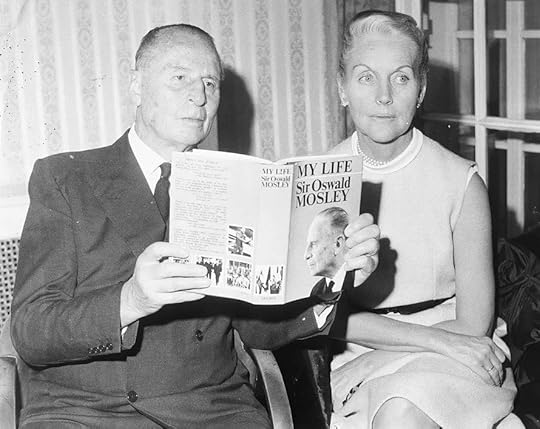
Mosley and his second wife, Diana
His Union Movement newspaper derided ‘concentration camp fairy tales’ while he also denied the Nazis had a conscious mechanical extermination programme. Mosley also adhered to the theory that Hitler was totally oblivious to the Final Solution.
After some years in Ireland, Mosley returned to the UK to run as an MP in the 1959 General Election for Kensington North and in 1966 for Shoreditch and Finsbury. Both times he was defeated. He then retired to France with his wife, where he wrote his autobiography, My Life, which was published in 1968. He denied he'd ever been an anti-Semite.
In his final years he suffered from ill-health and Parkinson’s disease. He died at his home in Orsay, near Paris, on 3 December 1980.
The wives

Mosley with his first wife, Lady Cynthia Curzon
Lady Cynthia Curzon
In 1920 Mosley married Lady Cynthia Curzon, a Labour politician and the daughter of the esteemed Conservative leader Lord Curzon of Kedleston. The wedding was a huge social event, at which even King George V and Queen Mary were present. But Lord Curzon (and many others) was convinced Mosley had only married his daughter for a shameless rise in the Conservative party's ranks. The marriage was blemished by Mosley’s endless affairs, including with both of his wife’s sisters and with their stepmother.
By the early 1930s, Lady Cynthia Mosley deviated from her husband's political ideas, being concerned about his move towards fascism.
Mosley and Cynthia had three children. Vivien (b 1921), Nicholas (b 1923), and Michael (b 1932). Lady Mosley died of peritonitis in 1933, when her youngest son was only one year old. It was also the year Adolf Hitler came to power in Germany.
Diana Freeman-Mitford
Oswald Mosley married his second wife, Diana Freeman-Mitford, in 1936, at the home of Nazi propaganda minister Joseph Goebbels. Diana had been Mosley’s mistress for a few years when he was still married to Cynthia. She left her husband, Bryan Guinness, heir to the brewing fortune, for Mosley, but he had refused to divorce Cynthia.
Diana was the third eldest of the six Mitford sisters, a family of famous aristocratic socialites who held controversial political views. some of them were friends with Adolf Hitler, others embraced Communism.
Hitler was one of the six guests at Oswald and Diana's marriage. He attended as the guest of honour. It was a secret wedding taking place at Goebbels’ house in Berlin. Hitler gave the pair a photo of himself in an eagle-topped frame.
Diana was as much an active fascist as her husband. She regularly drank tea with Hitler and had a strong affinity with him. They made plans for a pro-Nazi radio station in Britain, but this never materialised.
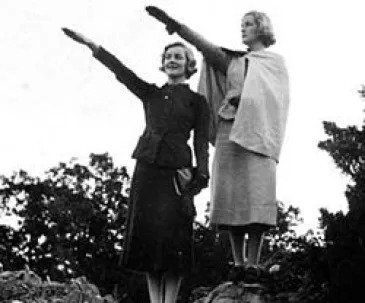
Diana and Unity, The fascist Mitford sisters
Diana and Mosley spent the first years of WW2 in prison. MI5 documents from 1940 that were released in 2002 revealed that the security services considered Diana the greater threat than her husband.
“Diana Mosley, wife of Sir Oswald Mosley, is reported on the best authority, that of her family and intimate circle, to be a public danger at the present time. Is said to be far cleverer and more dangerous than her husband and will stick at nothing to achieve her ambitions. She is wildly ambitious.”
In her obituary in the Guardian following her death in 2003, Diana was described as “the most hated woman in England”.
Mosley and Diana had two children, Oswald Alexander, in 1938, and Max, later the famous Formula One racing tycoon, in 1940.
Max Mosley was known for revolutionizing the sport and dubbed the ‘Godfather’ of Formula One.
September 18, 2022
Celebration Time For In Picardy’s Fields

In Picardy’s Fields is 2 years old on 20 September
On 20 September 2020 I came back to the Indie author arena as a historical fiction author by bringing out my first WW1 novel, In Picardy’s Fields.
After that nothing much happened. I had 12 preorders and a couple of lovely ARC team readers, who gave the book a boast by leaving an early review. I was meanwhile steeped into writing the 2nd book, The Diamond Courier on WW2, that was due for the beginning of December 2020.
Of course, I had high hopes and wild dreams about becoming a successful author and I’d done everything in my power to make that happen. At the time I had a flashy, expensive website, paid a fortune for the best historical fiction editor available, got a professional cover, etc. etc. etc. (Etc in this context mostly should be read as spending heaps of money seeing no revenues.)
I was only slightly disheartened that I wasn’t a bestselling author overnight. Though I’d spent all that hard-earned day job money on all these bells and whistles, I also knew I’d worked off my butt to release the best book I could at that moment in time.

At least, there was some recognition, and I plodded on. The real change came only after the third book, The Parisian Spy was released almost a year later, in July 2021. Then my books slowly got a little more love, and it was exactly as predicted. Most new authors need to have at least three books out to become trusted by readers. There are outliers, of course, that break all the records with their debut novel, but let me tell you those are usually not Historical Fiction authors.
I bought the book “In Picardy’s Fields” and wondered why the word Picardy was so familiar, then it came to me. Growing up in London during & after WW2, the song “Roses of Picardy” was often heard on the radio.— Marie Hindmarsh (Reader from New Zealand)
I haven’t heard that song for many years but it must have struck a cord. It was written by a British serviceman for a French woman who he fell in love with while she gave him shelter in her home. The song can be found on YouTube.

I am hoping for 5 more reviews and or ratings before Tuesday 20th, when it’s her real birthday, but 995 at 4.4 world-wide rating makes me a happy girl as well.
“For anyone wanting to travel back in time to experience history, courage and love ‘In Picardy’s Fields’ will take you there.”— Amazon Reader Review ⭐️⭐️⭐️⭐️⭐️

When I was busy writing and releasing In Picardy’s Fields two years ago, I couldn’t still believe I would continue to write in this series and be able to create a Box Set with the first 4 books.
And now, next week book 5, The Highland Raven comes out, and after that at least 3 to 5 more.
“I enjoyed this more than I can ever put properly into words! Great story with wonderful characters. Tears in my eyes about half the time. Loved this book!”— GoodReads Review ⭐️⭐️⭐️⭐️⭐️



